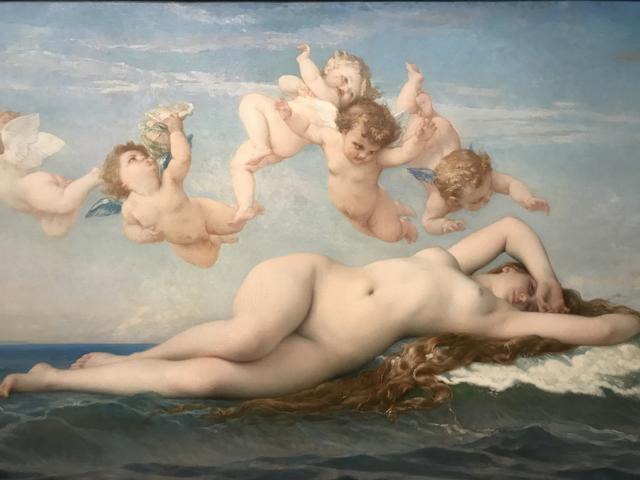The Birth of Venus - La Naissance de Vénus

The Birth of Venus, or La Naissance de Vénus in French, is a masterpiece painting created by the renowned artist Alexandre Cabanel in 1863. This oil painting showcases Cabanel's exceptional talent and mastery of the academic style, which was highly esteemed during the 19th century. The painting depicts the goddess Venus at her birth, a popular theme among artists of that era. Cabanel's interpretation of Venus emerging from the sea is both elegant and captivating, capturing the essence of mythological beauty.
The Birth of Venus was a major success at the Paris Salon in 1863 and was even acquired by Napoleon III, solidifying Cabanel's reputation as a leading artist of his time. The painting exemplifies the prevailing taste for classical themes and mythological subjects in 19th-century art, as well as the influence of the Second Empire on artistic expression. Cabanel's meticulous attention to detail and his skillful rendering of the human form are evident in every brushstroke of this iconic work.
One of the striking features of The Birth of Venus is the presence of cherubs surrounding the goddess, adding a sense of ethereal beauty and divine grace to the composition. While the theme of Venus's birth allowed artists to explore themes of sensuality and eroticism, Cabanel's interpretation remains tasteful and refined, emphasizing the goddess's role as a symbol of love and beauty. The painting invites viewers to contemplate the timeless allure of mythological figures and the enduring power of classical art.
Cabanel's The Birth of Venus stands as a testament to the artist's technical skill and creative vision, capturing the imagination of audiences then and now. The painting continues to be admired for its harmonious composition, delicate color palette, and evocative portrayal of a timeless myth. As a point of interest for art enthusiasts and tourists visiting museums, The Birth of Venus offers a glimpse into the rich artistic heritage of the 19th century and the enduring appeal of classical themes in art. Experience the beauty and elegance of Cabanel's masterpiece firsthand and discover the magic of The Birth of Venus at museums and galleries around the world.
© ChatGPT 3.5
Alexandre Cabanel was one of the most recognized exponents of classical art, who condemned anyone who deviated from what was established at that time. For Cabanel, painting did not have what was necessary to be considered a work of art and in fact he always found himself in conflict with Manet.
This was the painting that gave Cabanel the fame he enjoyed at that time, since he was appointed professor at the School of Fine Arts and was also elected as a member of the Academy of Fine Arts.
He was harshly criticized by Émile Zola and many others who believed that art would have to be much more social and have a much greater message than the frivolity that many believed that classical art had, proof of this is that Cabanel was one of the favorite artists of the bourgeoisie and he was even the favorite painter of Napoléon III. In fact when it was presented in 1863, it was part of many paintings that contained nudes.
Nowadays, it could be said that Cabanel is an artist who has been almost forgotten because history remembers artists who have taken more risks or who were much more outstanding.